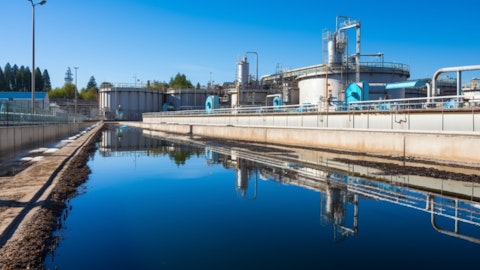SmartRent, Inc. (NYSE:SMRT) Q3 2025 Earnings Call Transcript November 5, 2025
SmartRent, Inc. beats earnings expectations. Reported EPS is $-0.03, expectations were $-0.06.
Operator: Hello, and thank you for standing by. My name is Mark, and I will be your conference operator today. At this time, I would like to welcome everyone to the SmartRent Q3 2025 Earnings Call. [Operator Instructions] Now I would like to turn the call over to Kelly Reisdorf. Please go ahead.
Kelly Reisdorf: Hello, and thank you for joining us today. My name is Kelly Reisdorf, Head of Investor Relations for SmartRent. I’m joined today by our President and Chief Executive Officer, Frank Martell; and Daryl Stemm, Chief Financial Officer. Before the market opened today, we issued an earnings release and filed our 10-Q with the SEC, both of which are available on the Investor Relations section of our website. Before I turn the call over to Frank, I would like to remind everyone that the discussion today may contain certain forward-looking statements that involve risks and uncertainties. Various factors could cause our actual results to be materially different from any future results expressed or implied by such statements.
These factors are discussed in our SEC filings, including in our annual report on Form 10-K and quarterly reports on Form 10-Q. We undertake no obligation to provide updates regarding forward-looking statements made during this call, and we recommend that all investors review these reports thoroughly before taking a financial position in SmartRent. Also, during today’s call, we will refer to certain non-GAAP financial measures. A discussion of these non-GAAP financial measures, along with the reconciliation to the most directly comparable GAAP measure is included in today’s earnings release. We would also like to highlight that our quarterly earnings presentation is available on the Investor Relations section of our website. And with that, I will turn the call over to Frank.
Frank Martell: Thank you, Kelly. Good morning, everyone. I’m pleased to report that the third quarter was a period of substantial progress for SmartRent. We continue to grow our annual recurring revenue and significantly narrowed our operating loss in line with the commitments we made on our last call. During Q3, we continued to expand our installed base, which now includes more than 870,000 units, up 11% from prior year. SaaS revenue grew 7% from prior year levels and now represents 39% of total revenue, up from 37% in Q2 of this year. SaaS growth is being fueled by our increasing installed unit footprint and higher pricing. As we look forward to the balance of this year and into 2026, we expect to continue to significantly expand our installed base as we capitalize on the investments we are making in our sales organization as well as expanding platform capabilities to deliver even greater ROI to property owners and operators.
Let me now highlight 3 important milestones from the quarter. First, we completed the actions necessary to reset our cost structure that we outlined last quarter, unlocking more than $30 million of annualized expense reductions. We believe that this will result in adjusted EBITDA and cash flow neutrality on a run rate basis exiting 2025. Cost efficiency was the primary factor in narrowing our adjusted EBITDA loss from $7.4 million in the second quarter of this year to $2.9 million in Q3. Second, our relentless focus on achieving profitability, combined with disciplined working capital execution helped us to exit the third quarter with unrestricted cash of $100 million compared with $105 million at the end of Q2. Maintaining our strong liquidity position should provide ample capacity to fund high ROI reinvestments, which are expected to drive customer and shareholder value and build a strong base for long-term success.
And third, we added a seasoned expert during the quarter with a consistent track record of transforming key workflows and processes. Our go-forward goal is to simplify and automate our key internal processes over the next 18 months. We expect to see significant financial and operational benefits from this initiative beginning in 2026. Our progress in Q3 is the outcome of clear priorities, disciplined execution and a focus on what matters most, building expanding profitable and durable platform. I will now focus the remainder of my comments today around our business model and why we believe it provides a platform for durable revenue growth and higher levels of sustainable profitability in 2026 and beyond. From my point of view, SmartRent’s opportunities for accelerating profitable growth and sustained market leadership are compelling.
We operate in a large expanding market with a purpose-built differentiated platform and a growing SaaS footprint. As a hardware-enabled SaaS company with meaningful scale, our foundation is domain expertise and close alignment with the needs of our customers. Our solutions are retrofit friendly, integrates seamlessly with third-party hardware and systems and are designed to deliver measurable ROI. With IoT-focused platforms deployed 870,000 rental units and over 1.2 million users relying on our operational and community management workflow tools, we have a significant advantage. I believe we are increasingly poised to leverage our scale advantage to improved operational execution, the introduction of new and enhanced capabilities driven by data and analytics and the infusion of AI.
SmartRent delivers strong value that our customers rely on. As a result, we have developed sticky and long-term customer relationships. Our net revenue retention rate is well above 100%. In a recent survey, 90% of property managers cited net operating income expansion as a key reason for continued investment in SmartRent. I want to conclude my prepared remarks today by saying how energized I am about the opportunities for growth and transformation at SmartRent. Over the past 4 months, I’ve had the chance to spend significant time with many of our key stakeholders, including our largest customers. These sessions have provided me with critical insights into both the company’s foundational strengths as well as areas we need to address to realize our full potential.

On the next call, I will be providing a 3-year strategic framework for evolving our business model to capture the unique benefits we provide to the rental market and its key participants. In closing, I believe we made important progress in the third quarter and are well positioned to exit 2025 with accelerating momentum. I want to thank our team of dedicated SmartRent employees for all their focus and commitment. It’s making a difference. I will now turn the call over to Daryl for a detailed discussion of our Q3 financial results.
Daryl Stemm: Thank you, Frank, and good morning, everyone. We appreciate you joining us today to discuss our third quarter 2025 results. Our third quarter results demonstrate clear progress across both profitability and operational execution, highlighted by reduced losses, lower operating expenses and a stronger recurring revenue mix, and we remain firmly on track to achieve our run rate targets as we exit 2025. For the third quarter of 2025, total revenue was $36.2 million, down 11% year-over-year. The decline primarily reflects our strategic move away from bulk hardware sales that occurred in advance of customer implementation time lines in favor of a more sustainable SaaS-focused revenue mix. Breaking this down a bit further, SaaS revenue reached $14.2 million and increased 7% year-over-year.
SaaS revenue now represents 39% of total revenue compared with 33% of total revenue in the same period prior year. Hardware revenue totaled $11.5 million in the third quarter, a 38% decline year-over-year for the reasons previously noted. And Professional Services revenue increased by 113% year-over-year to $7 million, reflecting the higher installation volume and improved project efficiency. The shift in revenue mix towards SaaS continues to strengthen the quality and predictability of our model, a key objective in our path to profitability. Our annual recurring revenue reached $56.9 million, up 7% year-over-year reflecting steady expansion of our recurring base and the successful execution of our strategy to scale higher-margin platform-driven growth.
As of September 30, our installed base reached 870,000 units, up 11% from the prior year, with 83,000 net new units added since the same quarter prior year. We deployed more than 22,000 new units during the quarter, a 49% increase compared to the prior year period and booked 22,000 units for a 30% increase, reflecting continued customer demand and stronger execution resulting from our investment in our sales organization. Turning now to profitability. Gross margin was 26%, lower year-over-year as a result of nonrecurring inventory charges related to our decision to sunset our parking management solution and focus on our core IoT and smart operation solutions, partially offset by a higher mix of our higher-margin SaaS revenue. Professional Services gross profit improved by $3.7 million, shifting from a loss of $3.5 million in the prior year quarter to a profit of $200,000 this quarter.
We believe the breakeven performance of our Professional Services revenue stream, which was driven by ARPU increases and cost reductions is sustainable. Operating expenses decreased by 34% year-over-year to $16.6 million, an $8.6 million reduction from the prior year period. Our third quarter operating expenses were aided by approximately $2.5 million of accrual reversals, which we don’t expect to recur in future periods. Net loss improved 36% year-over-year to a loss of $6.3 million and adjusted EBITDA improved 23% to a loss of $2.9 million. Our $30 million cost reduction program is complete. These efforts have meaningfully reshaped our expense base, aligning them with our current revenue level and created a leaner, more efficient operating structure that supports future growth.
We ended the quarter with $100 million in cash, no debt and $75 million in undrawn credit, giving us a strong balance sheet and the flexibility to execute from a position of strength. Net cash burn improved by 79% from roughly $24 million in the same period prior year to $5 million this quarter. This improvement is primarily driven by a reduction of operating losses and improved accounts receivable collections. From here, our focus turns to selective reinvestment especially in our sales and account management functions where we’re seeing early traction from targeted hiring and process improvements. Equally important, we’re investing in product innovation, as Frank mentioned, to strengthen differentiation and fuel long-term growth. We remain committed to preserving the cost discipline and operating rigor that have driven our turnaround.
We’re operating with discipline, building momentum and have clear line of sight to achieve run rate non-GAAP neutrality exiting 2025, positioning SmartRent for durable, profitable growth in 2026. Thank you for joining us today. Operator, you may now open the line for questions.
Operator: [Operator Instructions]. And your first question comes from the line of Ryan Tomasello.
Q&A Session
Follow Stein Mart Inc (NYSE:SMRT)
Follow Stein Mart Inc (NYSE:SMRT)
Receive real-time insider trading and news alerts
Ryan Tomasello: Looking at SaaS revenue growth of 7%, that came in lower than deployed unit growth of 11%. And it looks like the drivers there are ARPU related, which I think is partly driven by site plan. So I guess my question is, what’s the current strategy at site plan, which seems to be a drag on growth? And then within core IoT ARPU, it looks like that was still flat sequentially, backing out site plan. So are there any other drivers there to call out? I think you mentioned the sunset of your parking management solutions, whether or not that was an impact? Any color on that would be helpful.
Daryl Stemm: Yes. Thanks for the question, Ryan. So first of all, with regards to the overall SaaS ARPU, I would say that this is a 1 quarter aberration. We had some adjustments to revenue, SaaS revenue that were non-IoT related. So primarily smart operations were site plan as you mentioned. And that had an impact of about $0.15 on our reported SaaS ARPU number, which should correct itself in Q4. And so I would expect to see a return to the $5.65 to $5.70 range of SaaS ARPU in Q4.
Ryan Tomasello: Can you just elaborate what that — what those adjustments were?
Daryl Stemm: Yes. We have a number of accounting estimates that we make on both revenues and on expenses. And so the adjustments were really just around some estimates that we use in our calculations. And we’re constantly tweaking our estimates to make sure that our financial statements are reasonably representing to use the auditing term, our true financial results. This quarter, it was just a little bit larger than typical.
Ryan Tomasello: Okay. And then Frank, your commentary certainly is suggesting optimism about growing the installed unit base next year. Can you elaborate just on the progress you’ve made specifically within the sales organization? And if you’re able to, at a high level, discuss the type of annual unit deployment capacity you think the business can structurally support based on your current sales and installation infrastructure?
Frank Martell: Yes, look, I think I’m — the company has kind of settled in that 20,000 to 25,000 level. We can do more than that, significantly more than that with the current capacity. As I said in my prepared remarks, I visited most of the major clients. Everybody is talking about their plans, which include potentially quite a number of units to be installed. The macro environment is a little challenging. So that’s creating a little bit of friction. But by and large, I think there’s a lot in the hopper out there. We did add a leader about a year ago, terrific person that’s really driving expansion. We’ve expanded dramatically our account — key account management structure. We have a lot of, as you know, large clients. So more specific attention to those clients.
We launched a customer council, which we’re excited about, which will allow us to better coordinate our — some of our new products and solutions that we have in place. So that’s a positive. And then I think we have just more sales folks, some former employees that have come back, plus a few new ones. So we will, I think, be positioned well to ramp up from the current levels. We’re doing 22,000, 23,000 units right now. And I expect that to increase, but more to come on that front. And you mentioned site plan. So as Daryl alluded to, smart IoT and operations are the core of this company and will remain the core of this company. We’re actually holding serve at smart operations. We have over 1 million users. We’re putting some investment behind the solution sets there, and we’ll continue to do that, probably accelerate that into next year.
So smart operations is a core component. It’s is not declining. It’s kind of holding serve. So I just want to make sure that, that was clear.
Operator: And your next question comes from the line Yi Fu Lee with Cantor Fitzgerald.
Yi Lee: Great work on reaping operational improvements in the cost structure and flowing this benefit to better profitability. So Frank, I just want to start with you. You mentioned like the past 4 months, you spoke with a lot of stakeholders, right? Just want to get your feedback, like what are some of the positive and negatives you’re seeing in the field?
Frank Martell: Sure. Look, I think I’ve covered a lot of ground with customers. And I think one thing about SmartRent that’s very interesting is that the companies like the solutions very much. They value the return on investment that we generate. They’re very supportive of the company despite some of the challenges over the last year or so. And I would say it’s a very open collaboration. So I think from a customer point of view, it’s actually quite positive for SmartRent, support of SmartRent. And I think that’s fantastic. It’s also — it’s a collaborative discussion with them about how we can continue to evolve our products and solutions to be a bigger part of their business. And that’s why I think things — we did not have any problem creating our customer product council, which we’ve already kicked off and was very active.
So I think that’s, again, a kind of encouraging sign. And the last thing I’ll say is we don’t — we have very little to none customer turnover, which is not something that’s very common. And so I think from that point of view, we are a sticky solution. And I think from that perspective, it’s a great base to work with. So it’s really encouraging from that perspective. I think now that we’ve got more predictability in the business, I’m hopeful that we’ll see an acceleration in unit orders despite the fact that there’s some challenges in the macro environment.
Yi Lee: And with that, Frank, like, I know like, Ryan, asked about the sales organization. I want to continue to focus on that. You guys made a lot of investments from last year, bringing in a new CRO, hire a couple of folks in key pillars, right? Just want to get a sense, what are the things like in terms of go-to-market that you think — and you mentioned the run rate is about 20,000 to 25,000 units per quarter, right, of new net units. What are the go-to-market things that you think the changes you made that could help improve, let’s say, in 2026?
Frank Martell: Yes. I think, first of all, one thing I would just say on the unit count that Daryl talked about in his presentation, we’ve been working through the overhang of these bulk hardware sales that were made over the course of early 2024 and late 2023. That had a reduction — an effect of reducing our run rate on units because they were pulling forward into earlier periods. We should be through that by the end of this year. So we’ll have a run rate that looks more like the market demand cycle looks and that should be a benefit. It’s not very far from 23,000 to 30,000 units, really. And so we’re shooting for a much higher number and building the organization to accommodate that. And I think things like improving the sales organization in terms of numbers of people, and frankly, the underlying systems that support that group, that’s all well in hand.
As I said earlier, we have a fantastic leader that’s really doing a very good job on the organizational enablement front and also the client relationship building front. I will remain active with the clients. And I think there’s a lot of upside there.
Yi Lee: Got it. And then Daryl, flipping to you on the financial side. I think Frank mentioned that by the end of this year, the bulk hardware sales should normalize the headwind. I was wondering, can you give us some color? Does it mean like in 2026, we should see a smoother growth rate quarter-over-quarter? And then your comments about run rate cash flow neutrality to exit 2025, should we get used to this going forward, Daryl?
Daryl Stemm: Yes. So first — to answer your first question with regards to what the growth rate might look like, what you’ve been seeing for most of the past year is that our hardware revenues, in particular, have been muted because we’ve made the shipment of the hardware for much of the installation volume that we’re still now undertaking a year ago plus. So our — I would expect that even if our volume were simply to stay in the 20,000 to 25,000 units per quarter range, that our hardware revenue would increase as we have to, then as we work through the whole hardware sales, we will be shipping hardware for current period installation. So there’ll be a more closely coupled cadence to the hardware revenue with the deployment volume. And can you repeat your second question, please?
Yi Lee: The second one was the possibility. You mentioned our free cash flow exiting end of this year to be positive. So that — should we get used to this discipline — financial discipline in 2026, meaning like this consistency?
Daryl Stemm: Well, we’re certainly going to strive to be as disciplined as we have been this past quarter and for Q4. I think that our initial desires were simply to reduce the cash burn so that we can then evaluate how to use the $100 million of cash that we have in — and apply it for its best purpose, be it reinvesting in the company or otherwise. So my expectation would be that we’ll continue to remain very disciplined in our use so that we can then make very disciplined decisions around how to best use the $100 million.
Operator: There are no further questions at this time. That concludes today’s call. You may now disconnect.
Follow Stein Mart Inc (NYSE:SMRT)
Follow Stein Mart Inc (NYSE:SMRT)
Receive real-time insider trading and news alerts



